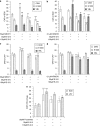Cultured CD4T cells and primary human lymphocytes express hOATPs: intracellular accumulation of saquinavir and lopinavir
- PMID: 19002102
- PMCID: PMC2597246
- DOI: 10.1038/bjp.2008.320
Cultured CD4T cells and primary human lymphocytes express hOATPs: intracellular accumulation of saquinavir and lopinavir
Abstract
Background and purpose: Drug efflux tranporters (P-glycoprotein (P-gp), multidrug resistance-associated protein (MRP)) limit the cellular uptake of human immunodeficiency virus protease inhibitors but the contribution of influx transporters in cells that (over)express P-gp or MRP is less clear. Here, we studied the expression of one influx transporter system, human organic anion-transporting polypeptide (hOATP), in some T-cell lines (CEM, CEM(VBL), CEM(E1000)) and in peripheral blood mononuclear cells (PBMCs) and examined the effects of manipulation of influx/efflux transporters on the uptake of saquinavir and lopinavir.
Experimental approach: The expression of hOATPs was studied by PCR. We used hOATP substrate or inhibitor (estrone-3-sulphate (E-3-S) or montelukast, respectively) and inhibitors of P-gp (XR9576) and MRP (MK571 and frusemide) to study functional interactions between influx and efflux transporters in the uptake of saquinavir and lopinavir. Lipophilicity of the drugs was measured by octanol/saline partition coefficient.
Key results: CEM cells, their variants and PBMCs express various hOATP isoforms, with OATP3A1 detected in all of the cells. MK571, XR9576 and frusemide increased the uptake of saquinavir and lopinavir. E-3-S and montelukast reduced the uptake of saquinavir and lopinavir in some, but not all, of the cells. Pretreatment of the cells with MK571, XR9576 or frusemide, followed by E-3-S co-incubation reduced the cellular accumulation of saquinavir and lopinavir. Lopinavir is much more lipophilic than saquinavir.
Conclusions and implications: Human OATPs, MRP, P-gp and lipophilicity determine the cellular uptake and retention of saquinavir and lopinavir. These data may have important implications for drug-drug interactions, drug safety and efficacy.
Figures



Similar articles
-
Concentration-dependent effects and intracellular accumulation of HIV protease inhibitors in cultured CD4 T cells and primary human lymphocytes.J Antimicrob Chemother. 2010 May;65(5):906-16. doi: 10.1093/jac/dkq082. Epub 2010 Mar 17. J Antimicrob Chemother. 2010. PMID: 20237075 Free PMC article.
-
P-glycoprotein, multidrug resistance-associated proteins and human organic anion transporting polypeptide influence the intracellular accumulation of atazanavir.Antivir Ther. 2009;14(7):965-74. doi: 10.3851/IMP1399. Antivir Ther. 2009. PMID: 19918100
-
Inhibition of P-glycoprotein and multidrug resistance-associated proteins modulates the intracellular concentration of lopinavir in cultured CD4 T cells and primary human lymphocytes.J Antimicrob Chemother. 2007 Nov;60(5):987-93. doi: 10.1093/jac/dkm353. Epub 2007 Sep 21. J Antimicrob Chemother. 2007. PMID: 17890284
-
Intracellular accumulation of efavirenz and nevirapine is independent of P-glycoprotein activity in cultured CD4 T cells and primary human lymphocytes.J Antimicrob Chemother. 2009 Nov;64(5):1002-7. doi: 10.1093/jac/dkp335. Epub 2009 Sep 11. J Antimicrob Chemother. 2009. PMID: 19748977
-
P-Glycoprotein and transporter MRP1 reduce HIV protease inhibitor uptake in CD4 cells: potential for accelerated viral drug resistance?AIDS. 2001 Jul 27;15(11):1353-8. doi: 10.1097/00002030-200107270-00004. AIDS. 2001. PMID: 11504956
Cited by
-
Cyanobacterial cyclopeptides as lead compounds to novel targeted cancer drugs.Mar Drugs. 2010 Mar 15;8(3):629-57. doi: 10.3390/md8030629. Mar Drugs. 2010. PMID: 20411119 Free PMC article. Review.
-
Concentration-dependent effects and intracellular accumulation of HIV protease inhibitors in cultured CD4 T cells and primary human lymphocytes.J Antimicrob Chemother. 2010 May;65(5):906-16. doi: 10.1093/jac/dkq082. Epub 2010 Mar 17. J Antimicrob Chemother. 2010. PMID: 20237075 Free PMC article.
-
Immunotoxic Effects Induced by Microcystins and Cylindrospermopsin: A Review.Toxins (Basel). 2021 Oct 8;13(10):711. doi: 10.3390/toxins13100711. Toxins (Basel). 2021. PMID: 34679003 Free PMC article. Review.
-
Influence of drug transport proteins on the pharmacokinetics and drug interactions of HIV protease inhibitors.J Pharm Sci. 2011 Sep;100(9):3636-54. doi: 10.1002/jps.22655. Epub 2011 Jun 22. J Pharm Sci. 2011. PMID: 21698598 Free PMC article. Review.
-
Interactions of tenofovir, Lamivudine, abacavir and Didanosine in primary human cells.Pharmaceutics. 2011 Jun 22;3(2):326-37. doi: 10.3390/pharmaceutics3020326. Pharmaceutics. 2011. PMID: 24310499 Free PMC article.
References
-
- Aarnoutse RE, Schapiro JM, Boucher CA, Hekster YA, Burger DM. Therapeutic drug monitoring: an aid to optimising response to antiretroviral drugs. Drugs. 2003;63:741–753. - PubMed
-
- Beck W, Mueller T, Tanzer L. Altered surface membrane glycoproteins in vinka alkaloid-resistant human leukemic lymphoblasts. Cancer Res. 1979;39:2070–2076. - PubMed
-
- Campbell SD, de Morais SM, Xu JJ. Inhibition of human organic anion transporting polypeptide OATP 1B1 as a mechanism of drug-induced hyperbilirubinemia. Chem Biol Interact. 2004;150:179–187. - PubMed
Publication types
MeSH terms
Substances
LinkOut - more resources
Full Text Sources
Miscellaneous

